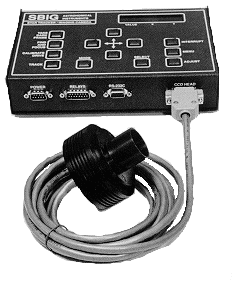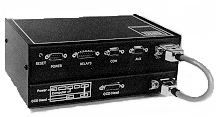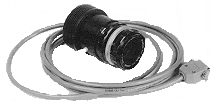S.B.I.G. MODEL ST-4 CCD IMAGING/STAR TRACKER SYSTEM:
The first real evolutionary leap in technology!
This model has been discontinued. It remains posted here for information purposes only.
For those who seek the latest technology in stand alone auotguiding systems we recommend the Model STV CCD Guide/Imaging System.

The Model ST-4 is a dual purpose instrument:
- When used with a personal computer (Macintosh or PC) can function
as an integrating, cooled CCD camera to capture images of very faint
objects. Carefully designed for astronomical and scientific imaging.
To predict actual field of view in degrees (horizontal or vertical)
when
using this CCD system with a telescope or a camera lens,
then employ the following formula:
- 57.3/Focal Length of Objective (mm) * 2.62
- When used with or independent of a personal computer installed on
a photoguide telescope, or at the guide port of an off axis guiding
device can detect any deviations in tracking of a telescope (in both axes), and
then trigger relays (housed within the ST-4 CPU) to send correction
signals via a relay cable to a telescope drive corrector controller; all of this
with a better frequency, higher accuracy and over a longer period of time than most
humans can perform. All of this resulting in professional quality
astrophotographs limited only by the quality of the telescope, and atmosphere.
STAR TRACKER FUNCTION:
The CCD detector consists of an array elements, called pixels. These pixels, which are arranged in 192 horizontal ("X" axis) and 165 vertical ("Y" axis) rows, convert photons (the light falling on the detector from a star) into electrons. When a guide star's image is present at a specific pixel the ST-4's microcontroller will note the increased signal intensity from that pixel relative to the others. An indication of the intensity of the signal and the location (X and Y coordinates) of the star on the detector are read on the ST-4's two digit LED display. As the telescope focuser is adjusted to improve focus (during the "Find and Focus" mode), more light from the star is focused onto a smaller area thereby increasing the intensity which is indicated on the display as a higher value; this is an aid to obtaining precise focus of the star.
The Model ST-4's interface to the telescope consists of a cable from the internal relays (normally closed/open) connector to the telescope drive corrector or hand control. The ST-4 will produce drive adjustments usually commanded by pushbutton switches. A manual override on the ST-4 panel allows the corrections to be made by the user.
By making fine adjustments to the telescope via the ST-4 control panel a guide star can be moved onto the detector, even onto any particular pixel. However, a guide star does not have to be centered onto the CCD detector for the system to function properly. The user can select the length of the star tracker exposure times from 0.1 to 20 seconds (default is 1 second); so stars ranging over 10 magnitudes in brightness can be tracked without adding optional filters. The area of pixels to be used (guide box) can also be adjusted to accommodate very long focal length guide telescopes, or mediocre atmospheric seeing conditions.
AUTOMATIC DRIVE CALIBRATION: Once an acceptable star is found, and when focus is achieved, the operator will push a "Calibrate Drive" button so the ST-4 will "learn" the characteristics of the telescope drive. The ST-4 sequentially activates relays which send a user selectable 1 to 10 second signal to the telescope drive corrector to move the telescope North-South and back, then East and West and back; the telescope will end up returned to where it started. This function "teaches" the ST-4 what commands will cause the telescope to move in what direction, and how fast. This calibration feature is invaluable when using a German equatorial mount, or an off axis guider, where the proper direction can be very difficult to guess.
Then the operator will select "Track"; any drifting motion of a star across the CCD causes it to appear at a different pixel at each following exposure. The microcontroller will then calculate how far the star has drifted and generates a control signal, transmitted through the relays to correct the position. The control signal, and its duration are a function of the star's position error. The microcontroller can take an exposure (integration), read out all the pixel values, and then calculate and transmit the necessary telescope correction in less than one second.
In the "Track" mode the ST-4 acquires a fresh star image, centers the image on a pixel and holds that star in position by constantly monitoring it sending correction signals to the telescope drive immediately after the exposure. The CCD is thermoelectrically cooled to enhance its sensitivity to dim stars. This extreme sensitivity enables guide stars as faint as 8th magnitude to be tracked utilizing as small as a 60mm guide telescope. The rapid calculating power of the computer enables the guide star location to be determined within a fraction of a pixel, enabling better than 1 arcsec tracking accuracy. An alarm signal relay is actuated if a guide star is lost.
Specifications of Model ST-4 CCD System:
| Resolution: | 192 x 164 Pixels, Texas Instruments TC211 CCD |
| Pixel Dimensions: | 13.75 microns x 16 microns |
| Array Dimensions: | 2.64mm x 2.64mm, 3.73mm Diagonal |
| Spectral Response: | 400 to 900nm |
| Dark Current: | 500 electrons/second |
| Full Well in (in Ke-): | 150 |
| Read Noise (in Ke-): | 150 |
| Binning: | No |
| Antiblooming Gate: | Selectable |
| Linear Response for Photometry: | Yes, selectable |
| Dessicant: | Yes, internal |
| Standard Control Software: | Macintosh or PC |
| Communications Port: | RS-232/422 Serial |
| Analog/Digital Converter: | 8 Bit |
| Total Pixels Imaging: | 31488 |
| Digitization Rate, Full Frame: | 0.7 Seconds |
| Image Transfer, Full Frame: | 18 Secs. @19.2 Kbd |
| Fastest Shutter Speed: | 0.50 Sec. |
| Longest Shutter Speed: | 5 Minutes. |
| Cooling From Ambient: | 30 Degrees |
| Power Requirements: | 12 V.A.C or D.C. (115 V.A.C. transformer provided) |
POPULAR AVAILABLE OPTIONS FOR THE S.B.I.G. ST-4:
- Company Seven can provide wiring diagrams of most common production
telescopes to show the user how to wire the provided relay cable with an
appropriate connector to plug into the telescope. Or, we may be able to
offer a TIC cable wired with a RJ11/14 connector for use with most
current production telescopes which already accommodate an autoguider
- Version 4.0 Rom Upgrade: adds many new Star Tracker menu features.
Included as the standard ROM on all ST-4's sold on January 1992 or later
- Upgrade CPU to ST-4X. Increases dynamic range to 14 bit thereby
reducing the noise by 10X, eliminating the readout structure glow, adds
the SBIG "Track & Accumulate" function, and supports tri-color Imaging. The
ST-4X CPU accepts the ST-6 imaging camera head upgrade

- FR-2 Focal Reducer Lens
- FR-4 Focusing Ring Collar
- Image Processing Software
- Parfocal Eyepiece to help to find, center, and focus an object
- SBIG Model CLA-1 Camera Lens Adapter

Go back to SBIG Products page
Contents Copyright 1994-2000 Company Seven - All Rights Reserved